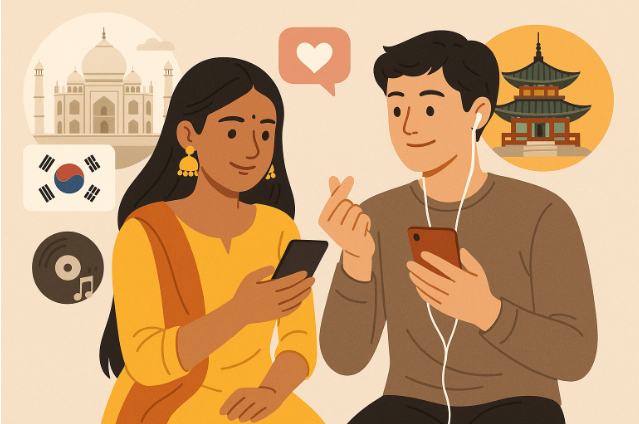
Today’s youth have been changing their cultural comfort zone from their roots to a vastly different foreign culture. There has been a huge social shift among young people toward the trends that define and dominate internationally followed pop culture and globally consumed drama. If you’re still unsure which place is being discussed, it’s the native land of two major brands, followed by passionate fame and fanfare—BTS and Blackpink. It must have rung a bell for you already. With Seoul as the capital, a dynamic metropolis, South Korea has been influencing youth all over the globe for quite some time now. And those most notably influenced are right around us: the youth of India.
As a writer, I might be wrong in labelling India’s youth as the ones most influenced by Korean culture, but one forms an opinion based on coherent observations. I see the young people around me celebrating Korean culture in all its grandeur and showing a growing interest in a different cultural experience. There might be many other followers of this culture, yet Indians surpass the levels of obsession and enthusiasm every day—kids included—who are in awe of the pop bands, collecting their merchandise, talking about them in groups, and even influencing their friend circles.
Undoubtedly, South Korea was a global leader even before the explosion of pop culture and K-pop groups. Yet it is only with the latter’s emergence that Korean culture began to be glorified among its young admirers. From Korean trousers to eating ramen—now a common feature on café menus—along with widely celebrated beauty practices and the chronic watching of K-dramas, the Indian youth have successfully absorbed and incorporated every bit of that culture into their lives, except for holding a visa.
This rapid incorporation of a foreign culture into the Indian backdrop has become a matter of criticism. Social critics have raised concerns about this transformation, pointing to the diminishing value of native beliefs and the growing distance from indigenous culture. The new generations are heading toward a newer cultural state. There are no definitive answers. But few seem to question why this change is happening so rapidly within a multicultural country itself. Why is the youth deviating? Or rather, what is the cause of this distance? There are several contributing reasons—not just one.
Firstly, the rise of the two major K-pop bands—BTS and Blackpink—transformed the global perception of pop culture. This sudden burst of vibrant popularity drew youth in with its glamour and energy. The members of these bands are young artists themselves, and their massive fame resonated with an admiring audience of young fans. A strong connection was established through these pop phenomena. K-pop idols became idealised figures across social media, and lifestyles began to change. Exposure to a modernised and passionately driven form of popularity made it irresistible for a rapidly modernising generation not to become participants. This influence affected not only their social and personal spheres but also their mental and emotional states.
As mentioned earlier, there isn’t just one factor. Another perspective aligns with the overwhelming entertainment value of K-dramas. The storylines offer a dreamy escape, especially the romantic ones. They encompass everything from the thrill of a crush to the pain of heartbreak. The emotions evoked go far beyond a simple screen connection. These romances are often idealised, creating unrealistic but deeply resonant notions of love and emotion for the youth. Their escapist imaginations are validated by the world of K-dramas. However, K-dramas aren’t limited to romance. As viewers explore this Korean entertainment further, it becomes clear how versatile and intriguing the storylines are—from family dramas to thrillers and even horror. It's as if they’ve mastered every genre of cinema.
When such idealised worlds are placed before young audiences, it's inevitable that curiosity leads to exploration. And that exploration often turns into admiration. The fashion is fascinating—trendy Korean pants and skirts, cute minimalist earrings, oversized T-shirts, and carefully styled looks. The food is exotic and is demanded to be tried—ramen has practically become a staple. Korean skincare and beauty products brought secrets that, once discovered, were rapidly adopted and celebrated—from ancient remedies to innovative formulas wrapped in unfamiliar scripts. The capital city, Seoul, has now become a dream destination for many, with its sparkling metropolitan lights that seem to flicker like fantasy itself.
Exploring and trying a new culture becomes threatening only when it begins to create a hybridised identity. But the question should not be about this new exploration. Instead, we should ask: where have traditional cultural ideals failed? Why are youth more interested in a foreign culture even when their own heritage offers such diversity? The fact is, tradition hasn’t made a strong effort to evolve alongside modern times. Tradition is undoubtedly a foundation. Without it, we wouldn’t have this rich present. But changing times call for evolving values—values that can be questioned, reshaped, and accepted again.
Change is not a loss of ideals, as some traditionalists and religious voices might argue. It is a reconstruction of existing ideals and culture. When an environment forcefully demands cultural loyalty, the ever-questioning youth will naturally turn to whatever is easier to understand and connect with.
